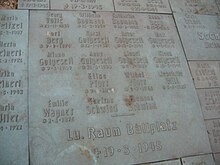Hanau main cemetery
The main cemetery in Hanau is the largest cemetery in the city of Hanau .
history


It was laid out as a Christian cemetery in the mid-1840s - at that time far from the city gates - and occupied from 1846. In doing so, he replaced the German cemetery, which was on the site where the courthouse is now in Nussallee, and the French cemetery , which was located in what is now the Martin Luther facility. The Jewish cemetery, however, remained. The relocation of the cemetery was necessary for hygienic reasons: the old cemeteries were very close to the city and also in the floodplain of the Kinzig . During the Second World War , the historical substance of the main cemetery was badly damaged by the air raids on the main station, which is located immediately south of the cemetery .
investment
The main cemetery was laid out in the form of a "piece of cake" between Birkenhainer Strasse and Dettinger Strasse , both of which are aligned with the honorary column here. This also forms the target of the visual axis at the main entrance to the cemetery. The cemetery was expanded two or three times in its rear area, i.e. to the east. The last two extensions left parts of the closing walls of the previous phases in place so that they are still clearly visible in the terrain.
The main entrance is dominated by the building of the mourning hall, which dates back to the post-war period, there is also the crematorium , which was extensively renovated after a long shutdown and reopened in 2003. Since January 28, 2003, cremations have been carried out again.
Special facilities
- In the front, oldest area there are a number of large graves of the leading middle-class Hanau families from the 19th century.
- Some tombs have been here from the German cemetery tranzloziert was largely overbuilt than the German cemetery early 20th century with the new courthouse (z. B .: Johann Georg Adolf of your ).
- Cenotaph for the fallen soldiers of the First World War
- Cenotaph for the victims of the bombing raids on the city of Hanau. 12 of the 15 bronze plaques that formed the centerpiece of the facility were stolen on the night of August 13-14, 2017. The memorial plaques were re-attached to the old location and the new facility was opened to the public on March 19, 2018 .
- Cenotaph for the fallen in World War II
- Cemetery of the forced laborers
- Memorial complex for deceased, premature children
- Islamic burial ground
The cemetery also contains graves, honorary graves (e.g. Lord Mayor Herbert Dröse ) and memorials (e.g. Elisabeth Schmitz ) for a number of well-known Hanau citizens.
meaning
The Hanau main cemetery as a whole is a cultural monument according to the Hessian Monument Protection Act .
literature
- Caroline Krumm: cultural monuments in Hesse - city of Hanau = monument topography Federal Republic of Germany - cultural monuments in Hesse. Wiesbaden 2006. ISBN 3-8062-2054-9 .
- Buried - but not forgotten . Wolfgang Arnim Nagel-Stiftung, Magistrate of the City of Hanau and Hanauer Geschichtsverein 1844 eV (Hg), 2008. ISBN 3-935395-12-4 .
photos
Honorary grave for Lord Mayor Karl Rehbein
Individual evidence
- ^ Lho: Shameful act on Hanau cemetery. Thieves steal memorial plaques for bomb victims .
- ^ Michael Sprenger: Annual report of the chairman . In: Minutes of the annual general meeting of March 7, 2019/2018 annual report of the Hanauer Geschichtsverein 1844 eV In: Neues Magazin für Hanauische Geschichte 2019, pp. 203–227 (217f).
- ↑ Krumm, p. 151ff.
Coordinates: 50 ° 7 '26.9 " N , 8 ° 55' 59.3" E






